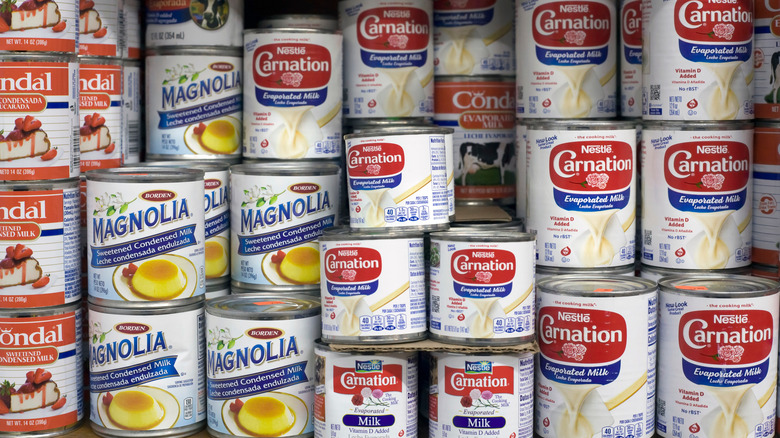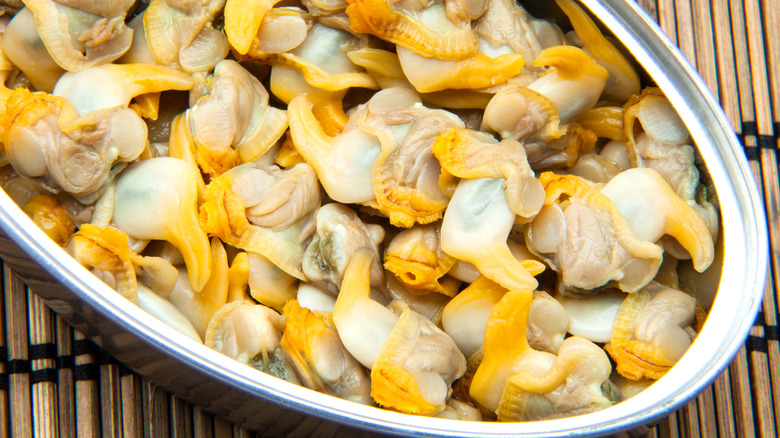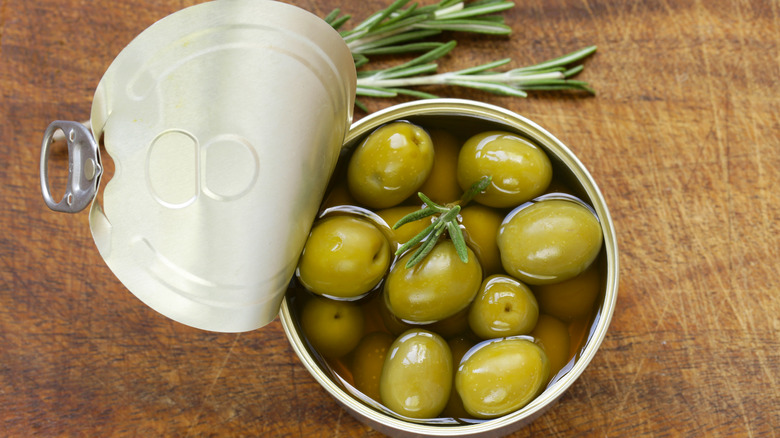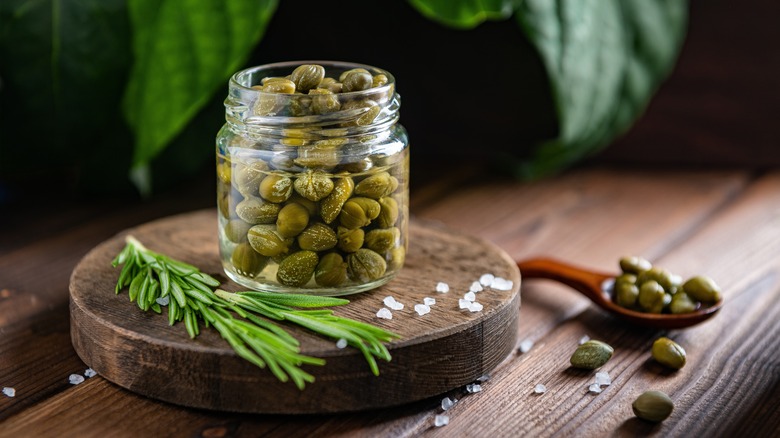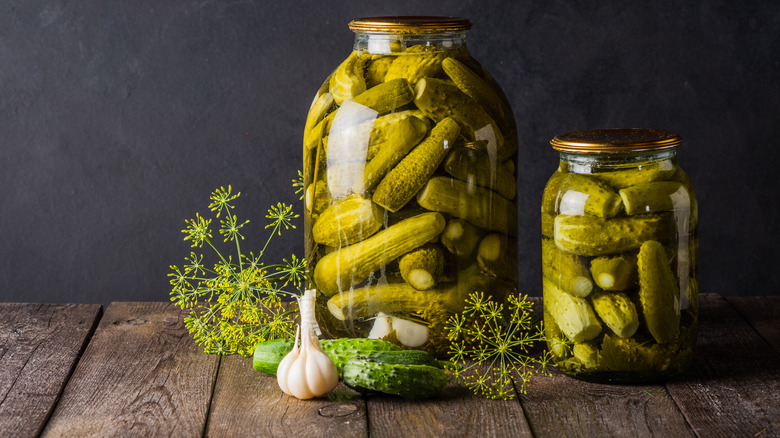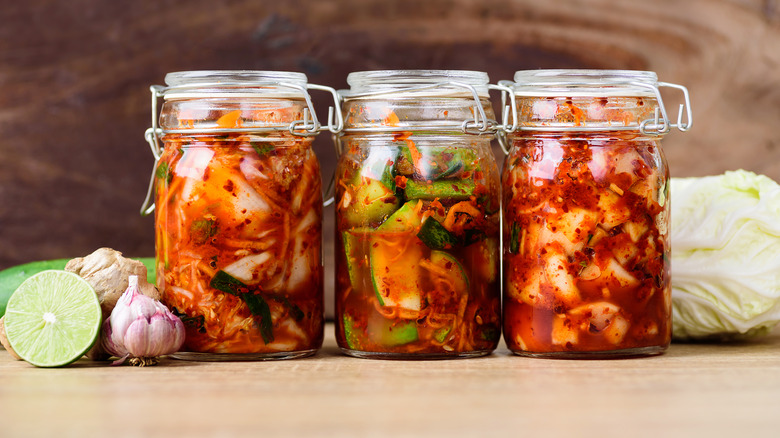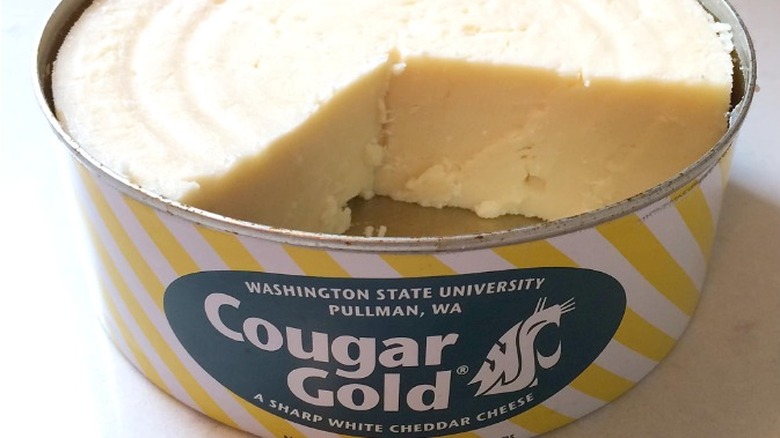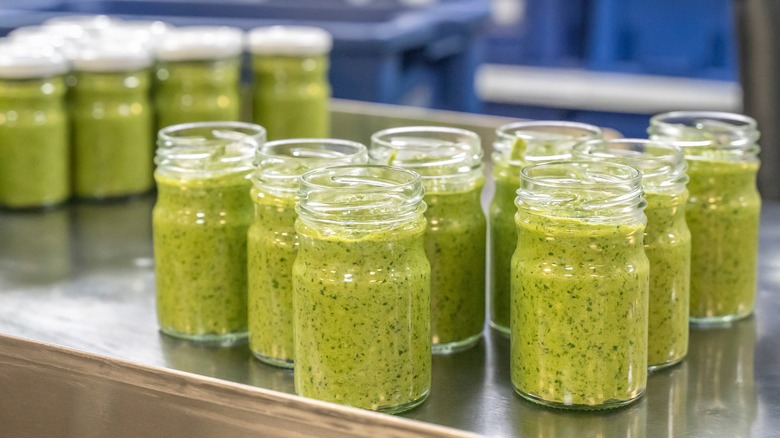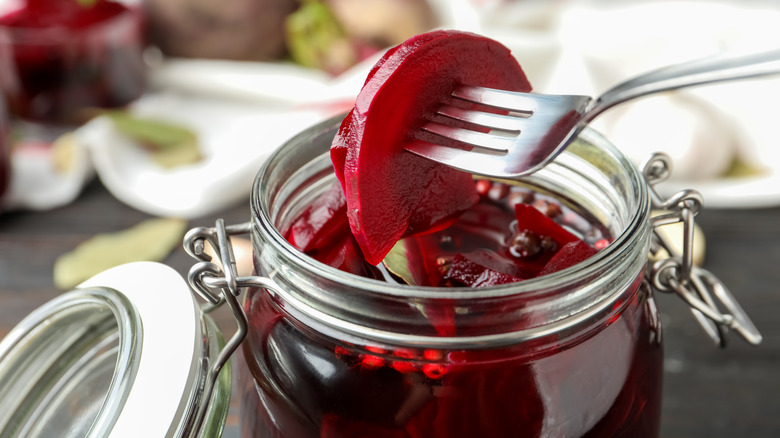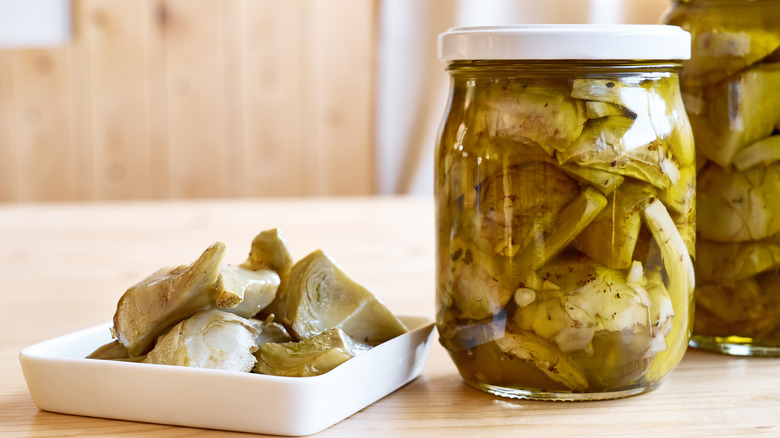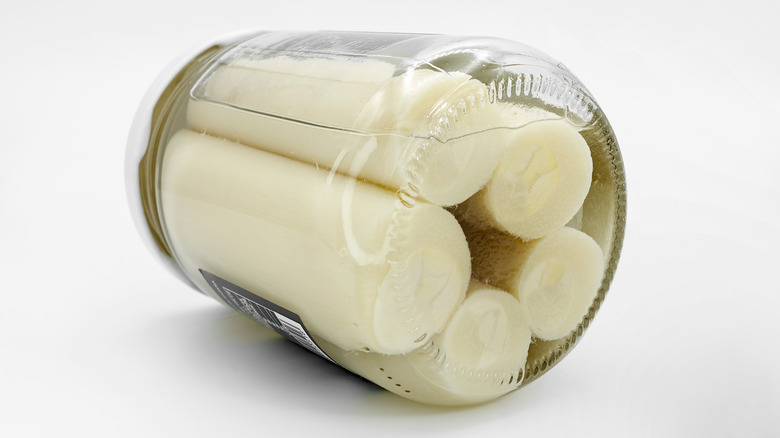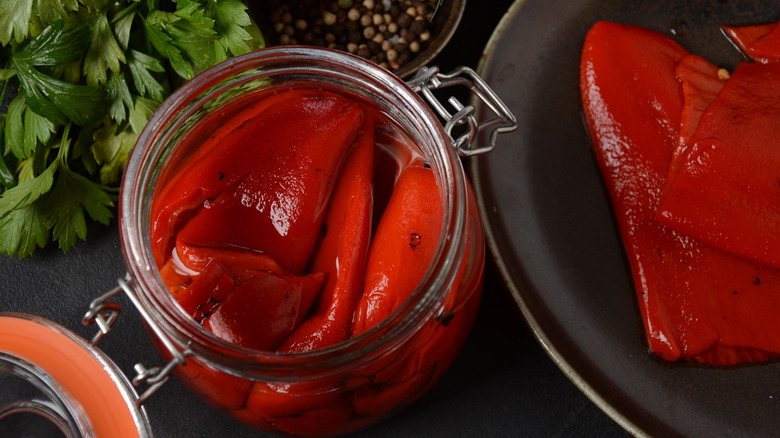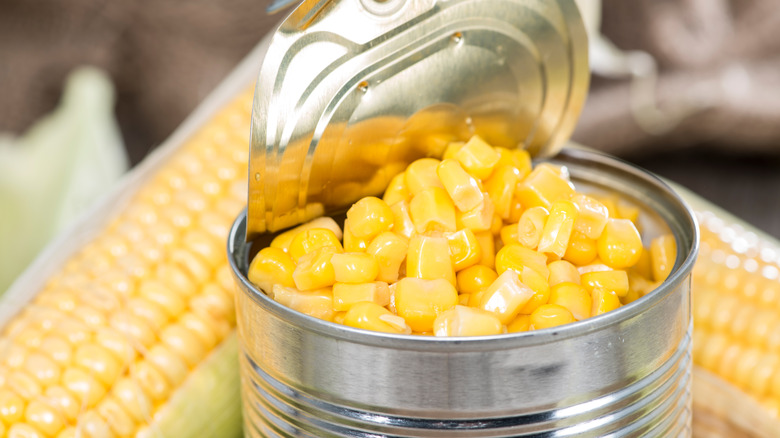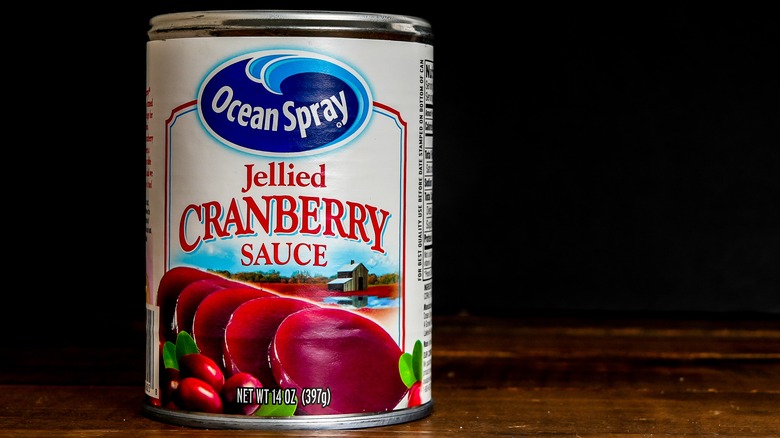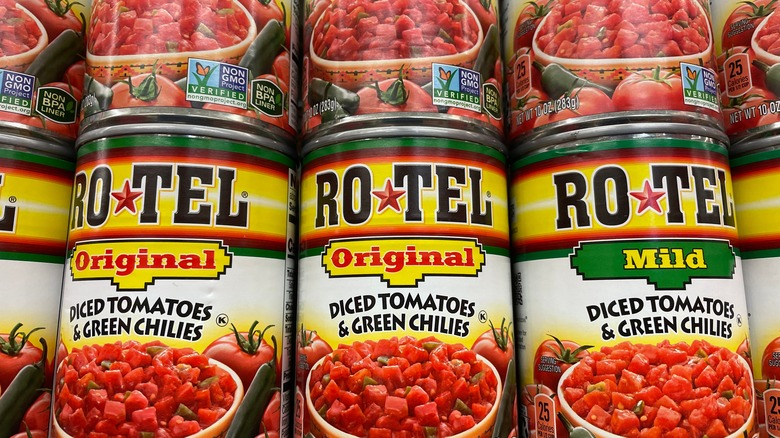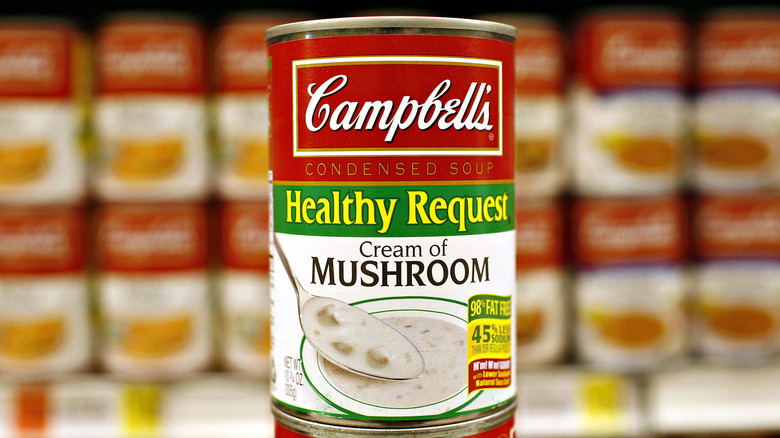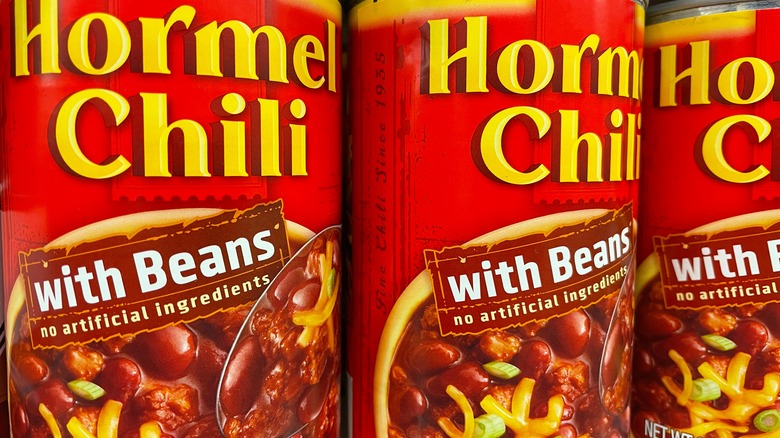The 21 Most Underrated Canned Goods You Should Try
No pantry would be complete without a few cans of beans, tuna, stock, and chicken noodle soup. But, the world of canned foods goes well beyond the staple items currently shuttered behind the doors of kitchen cabinets. Utilizing canned soups, sauces, flavor-enhancing seasonings, proteins, and vegetables will ensure a well-rounded quick, convenient meal is available in minutes providing flavor and nutrition.
The International Food Additives Council (IFAC) reports the first foods to be canned occurred over 200 years ago out of necessity when the English and French governments needed to feed military troops more nutritious foods than salted, cured meats and better food preservation methods. In 1810, IFAC finds that French chef Nicolas François Appert discovered that sealing and boiling jars at high heat keeps decay out, protecting the contents inside. The first American canned foods sales occurred in 1825 when Thomas Kensett and Ezra Daggert obtained one of the first patents for preserving animal substances in tin cans. By 2013, over 40 billion cans of food are estimated to be consumed in America and Europe each year (via IFAC).
A well-stocked pantry of jarred, tinned, and canned items is the key to transforming weeknight dinners into works of art.
1. Condensed milk
According to IFAC, the invention of condensed milk in 1856 cemented the canning industry in America, when Gail Borden produced the first self-stable milk to fight illness due to the lack of refrigeration in homes. Borden's Eagle Brand condensed milk brought the drink to communities without fresh dairy availability and is credited with lowering the infant mortality rate in America at the time.
Deciding when to use evaporated versus condensed milk depends on what you make. Reducing the milk removes over half of the water content, resulting in a thick, creamy consistency. Either option will work as a heavy cream substitute. Both products are produced the same way but evaporated milk does not contain added sugar. Today's Eagle Brand condensed milk products have roughly 21 grams of sugar in a two-tablespoon serving. Alternatively, evaporated milk is also often available as a fat-free option.
Both options provide silky richness when stirred into any food. Condensed milk is the secret ingredient for your Rice Krispie treats, and evaporated milk will do the same in mac and cheese, providing the richest, gooiest, perfectly melted cheese sauce.
2. Clams
The thought of a warm, comforting bowl of creamy New England clam chowder might sound perfect for dinner. Still, if the mess of having to steam and shuck the briny bivalve keeps you from diving into a hearty bowl of chowder-love, you are in luck. Turn instead to the tinned fish option your pantry should always have, canned clams.
You should start buying canned clams because they deliver all of the flavors without the mess of having to shuck and clean a fresh mollusk. Canned clams are available whole, chopped, or minced for easy use in any recipe. Most are packed in a briny stock that boosts the fishy flavor of a dish, like a homemade recipe for linguine with clams.
According to NOAA, the first clam cannery in the United States dates back to 1878 when Burnham and Morrill (B & M) first added clams to tins in Pine Point, Maine. Today B & M is best known for canned beans and the unusual but much loved New England favorite, canned bread.
3. Potatoes
An essential element to making a substantial bowl of chowder is potatoes, which take time and effort to prep and cook in raw form — time you may lack when preparing your mid-week meal. Luckily, potatoes are the canned shortcut you should be using.
Today reports the preparation for canning potatoes includes removing the skin, partially cooking them, and preserving them in water. As the potatoes are only partially boiled, you need to cook canned potatoes to finish their preparation. The canned starch's texture is soft but firm enough not to disintegrate when chopped and added to the chowder or made into a creamy dill potato salad recipe. We also love frying canned sliced potatoes in duck fat and finishing with a bit of truffle salt for an indulgent snack.
4. Crab
Fresh crab meat is expensive, even if cooking whole Dungeness crab is one of the high-yield options. And the prices will likely continue to rise as Alaska has canceled snow crab season in 2022. And imitation crab options taste, like the name suggests, fake. Thankfully, a can of crab meat at your grocery store will deliver quality and flavor at a more affordable price than the fresh lump crab meat in a fishmonger's case. Authentic crab also provides almost three times more protein and zero carbs than artificial stuff (via Healthline).
When shopping for tinned fish, we recommend buying a reputable brand that employs sustainable fishing methods versus bargain options. The higher price may be worth it as the cheap stuff may not follow ethically caught and processing sustainability or fishing regulations as name brands. Thankfully, many producers have removed the guesswork by including the Marine Stewardship Council seal on packaging, noting the brand's sustainability efforts. Though the tinned crab won't replace your king crab leg dinner, it seamlessly works in crab and corn chowder or Maryland crab cakes.
5. Anchovies
You may either love or despise the tiny, silver slivers of whiskered fish that dot the top of your Caesar salad. Anchovies add complex umami richness. There are over 140 types of anchovies thriving in the Atlantic, Pacific, Indian, and Mediterranean Oceans. The most widely consumed type is the European anchovy. The flavor of raw anchovies is quite ... fishy. Most are consumed straight from the jar and top sandwiches, salads, or pizza.
Besides their delicious savory flavor, anchovies provide heart-healthy nutrients. WebMD reports that flavor-packed fish are high in omega-3 fatty acids, good for heart and brain health, are rich in protein, vitamins, and minerals like selenium and calcium.
Tinned anchovies often contain bone, so shelf-stable anchovy paste is a suitable alternative. Enhancing the depth of flavor in dishes like Ina Garten's ultimate tuna melt (but anchovies should be added to more recipes).
6. Olives
In the early 20th century, canned olives almost destroyed the canned foods industry. Smithsonian Magazine reports that in 1919, botulism from bacteria-ridden canned olives killed 19 people in America, and it could have been the end of the country's canned food industry. Instead, government officials, canned food purveyors, and scientists worked together to understand why the bacteria occurred and create regulations to ensure it would not happen again, saving the industry, according to Smithsonian.
Today, cans and jars of salty, creamy, nutty, and bitter olives deliver an earthy, grassy burst of flavor encased in a dainty sphere of nutrition. Healthline reports olives are a vital component of the uber-healthy Mediterranean diet, filled with healthy fats, vitamins, and minerals, an abundance of antioxidants, and virtually zero net carbohydrates.
Aside from being good for you, briny olives enhance the umami flavors of foods. They cut through the fattiness of rich cuts of salumi and cheese on a charcuterie board and add a salty bite to Greek salad. Olives are also key to the best sandwich in New Orleans, and what we think is one of the key ingredients to a perfect martini.
7. Capers
Capers are tiny morsels of salty, herbaceous, lemony flavor packed into a pea-sized pod. Capers are immature flower buds from the caper bush with a history dating back to 2000 B.C. Caper bushes thrive throughout the Mediterranean, growing wild throughout Morocco, Greece, and Italy.
With a scant calorie count, zero sugar or fat, and healthful benefits in fighting cancer and Alzheimer's disease, you should always keep capers in your pantry. A sprinkle of capers adds a salty pop of welcome flavor to hot or cold dishes. We love a dash of the unripe, cured buds atop our smoked salmon fry bread, using the brightness of the lemony, salty caper to cut through the fatty richness of the smoked fish and fried bread. Or, add a spoonful to pesto as the game-changing ingredient that will transform the spread to a savory, umami-rich fish, chicken, or pasta enhancement.
8. Pickles
The history of pickles dates back thousands of years before Peter Piper picked a peck of pickled peppers. The early Mesopotamians were the first to soak cucumbers in brine to preserve them over 4000 years ago.
History explains that salty, sour, and tangy pickles first arrived in the New World in 1492 when Christopher Columbus' ships anchored in the Caribbean. By the mid-1600s, Dutch immigrants were selling pickled cucumbers out of barrels along the streets of New York City. ABC 7 adds that by the 1800s, pushcarts replaced barrels, and y the early 1900s, over 3000 immigrants were selling dill and garlic-infused jumbo pickles out of carts on the city's streets, mainly on the Lower East Side.
Cucumber pickles are high in water content, have few calories, and have zero fat (via WebMD). They are high in salt content, so adding the brine-y cukes to your diet should be done in moderation. However, a Cuban sandwich recipe would be amiss without a thinly sliced dill pickle nestled between the ham and the cheese. We can't imagine enjoying a scrumptious BLT sandwich without a spear on the side.
9. Kimchi
Pickling food for preservation has been a part of every culture for centuries, including Korea, where spicy, salty, and slightly funky kimchi is a staple in the country's diet. Colorado State University shares that there are over 200 different types of kimchi produced in the country. Although the spicy red baechu style made from Napa cabbage slathered in spices and chili paste is one of the most common, the combinations of these fermented vegetables will vary based on the region, vegetable, and ingredients.
BBC Good Food adds kimchi is a fermented product, like sauerkraut. A staple ingredient in the Korean diet, BBC reports kimchi is traditionally made by brining vegetables then adding them to earthenware pots with spices and burying them in the ground for weeks to months to ferment, developing a salty, sour mix of complex flavors. The longer the vegetables ferment, the more funky, sour flavors and pungent aromas will emerge.
Thankfully, dozens of kimchi brands on the market tackle the time-consuming process, offering ready-to-eat options available in the cold case at local supermarkets (the chill slows the fermentation of the pickled vegetables).
10. Cheese
For cheese lovers, canned cheese is the item you should always have on hand. We aren't talking about the heavily processed can of Easy Cheese you likely enjoyed by spraying straight from the container into your mouth. We're talking about Cougar Gold canned cheddar cheese, one of the most delicious creations out of Washington State University. It is one of the foods you need to try from the Pacific Northwest.
The history of Cougar Gold began with the government funding development of the best preservation method for cheese and has become one of the school's most beloved products, produced on-site at WSU's creamery for more than 80 years. Cougar Gold cheddar cheese must be refrigerated and, when kept sealed and chilled, will last for years, increasing in sharpness and flavor over time (via WSU.edu).
11. Pesto
The herbaceous bite of fresh pesto made from fresh summer basil in a roasted chicken Genovese will transport you to Italy with a single bite. However, fresh pesto's earthy, herbal, and grassy flavor is enjoyable year-round, thanks to the high-quality jars of store-bought pesto in the refrigerator section of your grocery store.
A smear of store-bought pesto will transform the flavor of grilled salmon, elevates salads and crudités, and tofu pesto pasta will revolutionize how you make the creamy pasta sauce forever. We love adding a dollop into a bowl of tortellini en brodo, adding garlicky, herbal, nutty notes to the rich broth and cheesy pasta.
12. Beets
Delivering the perfect combination of earthiness and sweetness, keeping cans of beets in your pantry keeps your fingers from turning purple when you're craving a warming bowl of borsht soup. The cans are huge time savers as the root vegetable traditionally has a long cooking time. Though double-cooked and canned, they maintain nutritional value.
And don't discard the inky purple brine of the canned vegetable. A spoonful or two of the juice will turn mashed potatoes into a pink-hued masterpiece perfect for Valentine's Day dinner, or submerge a few hard-boiled eggs into a mix of vinegar, sugar, and the juice for the prettiest pickled eggs that your salad will love.
13. Artichoke hearts
Whole fresh artichokes are a wonder to behold. Looking like a beautiful flower, artichoke leaves hold edible fiber leading to an earthy, nutty heart at the core of the thistle. Enjoying whole artichokes dipped in garlicky butter is a delightful delicacy. However, preparing whole artichokes is laborious and often not worth the time.
Instead, you may want to use canned artichokes, with the hearts trimmed and packaged in a slightly salty brine or marinated with herbs and olive oil. Canned artichokes may be the most cost-effective way to enjoy the hearts versus buying and preparing fresh or frozen options.
Artichoke hearts add a tangy bite to salads, antipasti, and pizza. And, of course, we love them mixed into the classic hors d'oeuvre: spinach and artichoke dip.
14. Heart of palm
If the thought of eating the core of a tree sounds unappetizing, you have yet to try heart of palm. Healthline notes the white vegetable comes from the center of a palm tree, often the coconut palm that produces coconuts for milk and meat. The giving tree's inner white core has an asparagus-like texture, a flavor similar to artichoke, and loads of antioxidants and nutrients. The health site adds that the low-calorie, fibrous vegetable delivers high potassium, copper, and phosphorus levels in a single serving.
Adding heart of palm to salads gives a nice crunch and nutty flavor to a mix of peppery arugula or spinach. Whirl the hearts into a veggie dip with fresh herbs, lemon, and olive oil. It is even a keto-friendly alternative to pasta, with cans of shredded heart of palm noodles becoming widely available in markets.
15. Roasted red peppers
Roasted red peppers elevate the flavor of everything from hummus to soup to red pepper tapenade, but the roasting, peeling, scraping, and de-seeding makes producing them time-consuming. There is no need to go to the hassle when jarred options are plentiful, making your antipasti platter prettier, adding the sweet, slightly charred flavor to pizza or pasta, or blending with cream and garlic into a creamy sauce for pasta.
Red bell peppers are the ripest in the bell pepper family, making them the most nutrient-rich, according to WebMD. The ruby-colored veggie enjoys an abundance of vitamins and minerals, including vitamins A and C, calcium, potassium, and beta-carotene. The health site adds roasting the pepper does reduce some of the nutrient value. However, the overall nutritional benefits are still very high.
16. Corn
The taste of just-harvested sweet corn on the cob is one of the great gifts of the summer harvest. However, the availability of fresh corn is sadly seasonal. Thankfully canned corn makes a flavorful substitute year-round. Corn is special for Green Giant brand because it was the first vegetable the 100-plus-year-old company packaged, starting with canned creamed corn in 1907. Today, Green Giant is one of the largest producers of canned corn in America.
Statista shares the average American consumes around 36 pounds of corn each year. Healthfully adds that the vegetable is high in vitamins and minerals like heart-healthy folate and B vitamins. Canned corn brings sweet and savory flavor to everything from cornbread and tortillas to creamy corn pudding and fresh corn salad — even in winter.
17. Coconut milk
You should always have coconut milk in your pantry. It is a lactose-free go-to for adding cooling richness to spicy Thai or Asian soups and curries. It gives creamy, nutty flavors to anything from smoothies and sorbet. It is also the defining ingredient in a spicy bowl of hearty red pepper soup and frozen pitchers of piña coladas
Unlike coconut water, which comes from young, green coconuts, coconut milk is from mature brown coconuts. The milk provides a bounty of health benefits with an indulgent, tropical flavor that transports you to the islands. To make coconut milk, the flesh of ripe coconuts is shredded and simmered with water to create a creamy, milky consistency.
While the caloric count of coconut milk is high, with most calories coming from fat, Healthline adds that this plant milk has a bevy of vitamins and minerals, including iron, potassium, manganese, and selenium. Coconut milk in your diet could help reduce inflammation and lower bad cholesterol.
18. Cranberry sauce
A can of cranberry sauce may only cross your home's threshold on Thanksgiving Day. It pours from the can with the rings intact as a guide to cut slices of the jellied fruit. However, keeping a few cans handy will become a quick time saver in making anything from cocktails to marinades.
We love it boiled down with orange juice into a thick glaze for baked ham, to cook the sauce with smoky chipotle sauce for a sweet and spicy marinade for a chicken, or to pour over goat cheese. A spoonful of cranberry sauce gives a pop to cranberry brie bites. Its tanginess cuts through the rich cheese and buttery pastry, creating the perfect cocktail hour canape. Pair with a frozen cranberry Cosmopolitan and you may never use plain cranberry juice in your vodka cocktail again.
19. Ro-Tel
You have likely purchased a can of Ro-Tel only when creating a Sunday game-day batch of meaty Rotel queso dip. However, the spicy canned diced tomatoes with green chilies and a secret mix of spices make the perfect addition to soups and stews — it will change your sausage gravy forever.
Ro-Tel says that Carl Rottele began canning tomatoes in Elsa, Texas, in 1943. Shortening his name to ensure customers could pronounce it correctly, Rottele began selling the cans to cities close to Elsa, where Houstonians and Dallasites began adding the cans to chili and soup recipes. Word quickly spread about the quality and fresh flavor that the canned tomatoes had, driving an expansion of the brand throughout the country.
Today, the product line includes the original, mild, and hot versions. We love spicy hot Ro-Tel in our white chicken chili recipe adding a punch of zesty heat to the hearty dish.
20. Creamy soup
It should be no surprise that canned soup reigns supreme in the pantry. Cans of chicken noodle soup are the classic all-American staple cold-fighter when anyone in your house begins to cough or has a sniffle. But, beyond the nourishing classic, we love creamy canned soup as a quick and easy base in casseroles (yes, green beans, we are thinking of you).
With a texture similar to a bechamel sauce, creamy soup thinned with a bit of milk or water acts as a time-saving rich foundation for creamy baked dishes. Cream of mushroom soup has become a Thanksgiving shopping-list requirement, delicious in leftover turkey pot-pie. Beyond mushrooms, creamy soup options include everything from chicken and celery to potato, tomato, cheese, and more.
21. Chili
The key to making great chili is time; if time is the ingredient you are short of, you should always have canned chili in your pantry instead. Texas Monthly shares that America's introduction to chili likely came from Canary Island immigrants who settled in San Antonio, bringing a stew of meat, onion, garlic, chilies, and spices like cumin and coriander, also known as chile con carne or chili with meat. The dish is called the official state dish of Texas.
Turning to canned chili delivers the characteristic flavor of slowly simmered chili without the hours of stirring at the stove. Not all chili is the same, so our guide to the best-canned chili will help you find the one to fit your palate, including meat-free, vegan, no bean, spicy, and more.
With cans of chili awaiting use in our pantry, your creative juices should flow with dinner ideas, from making ball-park style chili cheese dogs, topping tamales, stuffing baked potatoes, or spooning over enchiladas. Or, enjoy it straight, adorning your bowl with cheese, sour cream, and scallions for a comforting taste of the southwest.

